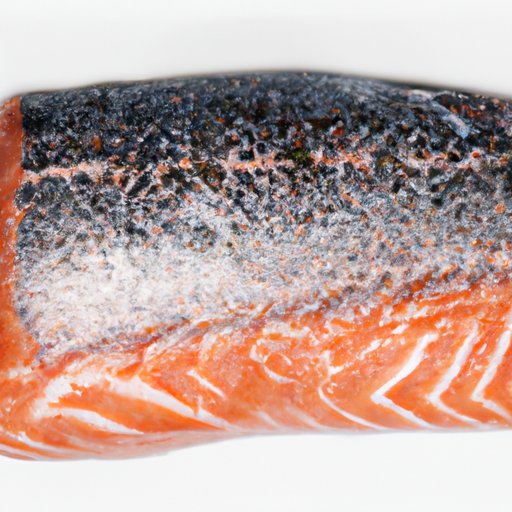
I. Introduction
Salmon is a popular fish that is enjoyed all over the world. However, cooking it to perfection can be a daunting task as it is easy to undercook or overcook it, both of which can ruin the taste and texture of the fish. In this article, we will explore various methods of determining if salmon is cooked properly, so you can enjoy a delicious and healthy meal.
II. Temperature
One of the most important factors in cooking salmon is temperature. It is essential to cook salmon at the right temperature to ensure any bacteria is killed off and the fish is cooked thoroughly. The easiest way to do this is by using a meat thermometer.
Insert the thermometer into the thickest part of the fish, making sure it doesn’t touch the bone. The temperature should reach 145°F (63°C) at the center of the fillet. If you don’t have a thermometer, you can also use a fork to check the internal temperature. Pierce the thickest part of the fish, and if it flakes apart easily, it is cooked through.
Remember to wash the thermometer with hot soapy water after each use.
III. Texture
Texture is important in determining whether the salmon is cooked properly. The texture of the fish should be moist and tender, rather than tough or rubbery.
To check the texture, press the fillet gently with your finger; it should feel slightly springy to the touch and not resist your finger. Overcooked salmon will feel firm and have a dry texture, while undercooked salmon will feel soft and look raw. Additionally, a cooked salmon fillet should slightly flake when pressed with a fork and be easy to separate from the skin.
IV. Color
The color of the fish is another indicator of its readiness. Raw salmon is usually a deep pink or orange color, while fully cooked salmon will be a lighter pink or opaque white. Undercooked salmon will still have a translucent center that appears raw, whereas overcooked salmon will be grey and dry.
Keep in mind that wild salmon will have a deeper reddish color than farm-raised salmon, which can be a lighter pink or peach color.
V. Timing
Timing is crucial in cooking salmon, as it needs to be cooked thoroughly without overcooking it. The time it takes to cook salmon varies depending on the thickness of the fillet. As a general rule of thumb, you should cook a 1-inch-thick fillet for 12-15 minutes, while a thicker fillet will require an additional 3-5 minutes of cooking.
It’s important to note that cooking times may vary based on factors such as the cooking method, oven temperature, and starting temperature of the salmon. Always check the internal temperature with a thermometer or by flaking the fish to make sure it is cooked through.
VI. Skin
The skin of the salmon adds flavor and texture to the dish, but not everyone likes to eat it. If you choose to leave the skin on while cooking, it is important to check that it is cooked properly.
When the salmon is cooked, the skin should be crispy and easy to remove. If it sticks to the pan or feels slimy, it’s likely undercooked.
VII. Piercing
Piercing the salmon with a fork is a quick way to check if the fish is cooked throughout. Pierce the thickest part of the fillet with a fork and twist the fork slightly. The flesh should flake apart easily and be opaque all the way through. If it still feels raw, you will need to cook it further.
VIII. Resting
Resting the salmon after cooking is important for several reasons. It allows the fish to finish cooking fully while retaining its juices, which helps to enhance the flavor and texture of the fish.
Once the salmon is removed from the heat source, let it rest for 5-10 minutes before serving. This allows the cooking process to finish and allows the juices to redistribute throughout the fillet.
IX. Conclusion
In conclusion, there are several ways to determine if salmon is cooked properly. By using a thermometer, checking the texture, color, timing, skin, piercing, and resting, you can ensure that your salmon is cooked to perfection. Remember to be cautious and follow the directions carefully, as overcooking or undercooking can spoil the taste and texture of the fish. With these tips and techniques, you’ll be able to cook delicious salmon that’s both healthy and flavorful.
So next time you’ve got a salmon fillet to cook, give these methods a try. You’ll be pleasantly surprised at how easy it is to get perfectly cooked salmon every time!
X. Tips and Warnings
– Always check the internal temperature of the fish to ensure it is cooked through.
– Use a meat thermometer to get an accurate reading.
– Remember to let the fish rest for a few minutes before serving.
– Overcooked salmon will have a dry texture, while undercooked salmon will look raw.
– Farm-raised salmon may be a lighter color than wild salmon.




